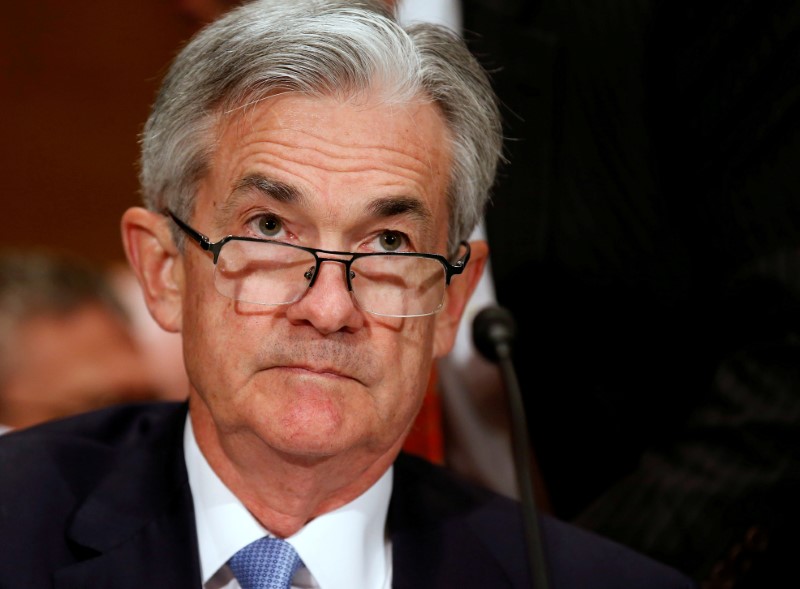(Bloomberg) -- Federal Reserve Chairman Jerome Powell’s embrace of his predecessor’s gradual approach to tightening monetary policy is about to be tested.
Since Powell accepted President Donald Trump’s nomination almost four months ago, the near-term outlook has changed significantly.
Financial volatility has awakened, and a booming stock market has shown it can also go down. A $1.5 trillion tax package is adding stimulus to the U.S. economy at a time of very low unemployment and solid growth, a trend that could red-line demand and kick up a central banker’s worst enemy -- inflation. The government wants to test the limits of the world’s appetite for its debt, a boost in supply that’s putting upward pressure on market interest rates.
For Powell, who delivers his first congressional testimony as Fed chairman on Tuesday, there’s suddenly a lot more political and economic risks testing the new leader from the outset.
“In this environment, you will have more combativeness between fiscal and monetary policy,” said Diane Swonk, chief economist at Grant Thornton in Chicago. “Debt-financed fiscal stimulus is hitting the accelerator on growth at the very moment the Fed was attempting to tap on the brakes.”
Former Fed Chair Janet Yellen pursued a policy of ultra-patience, letting the economy work through headwinds of tight credit and weak confidence. She raised benchmark lending rate just five times over her four-year tenure. She also exploited a period of low inflation to test the limits of labor market slack.
Three vs Four
The margin Powell faces to continue to run the economy hot is slimmer. The unemployment rate was 4.1 percent last month and forecasters expect it to drop into the 3s this year. The debate inside the Fed will intensify over the pace of tightening. Policy makers penciled in three hikes in December, but just a few weeks later they boosted their outlook for growth, according to minutes from the January Federal Open Market Committee meeting.
FOMC participants “anticipated that the rate of economic growth in 2018 would exceed their estimates of its sustainable longer-run pace and that labor market conditions would strengthen further,” according to the minutes released Feb. 21.
Because his testimony is happening before the FOMC formally updates its forecast next month, Powell will have to manage the tension between an upgraded economic outlook and a policy path that is still stuck at three hikes from December, said former Fed Governor Laurence Meyer. Firms such as JPMorgan Chase & Co (NYSE:JPM)., Goldman Sachs Group Inc (NYSE:GS). and Meyer’s own policy analysis firm predict the central bank will hike four times this year.
“He has to say that the economy is stronger than expected, that fiscal stimulus is adding to that strength, and that unemployment will fall more than expected,” Meyer said. “The tension is that the policy guidance, including in the January minutes, seems out of date and out of line with the evolving outlook.”
Indeed, the forecast is more complicated and less certain. Nobody knows, for example, how high market interest rates have to go to attract buyers to fund the increase in government bond issuance. The question for Powell is how to respond to tighter financial conditions and some crowding out of private financing.
If nothing else was changing, the Fed could simply back off the pace of rate hikes for a while as higher financing costs offset fiscal stimulus. Tighter financial conditions would be welcomed.
But Congress is adding more demand at a time of the lowest unemployment since 2000, and with some measures of inflation forecast to move higher. The Fed cautioned in its Monetary Policy Report to Congress Friday that the labor market appeared “near or a little beyond” full employment.
No Fed chief wants to tangle with an administration’s spending plans. But it seems inevitable that Powell is on a collision course with deficit politics. “It puts him in a position of responding to fiscal stimulus,” said UBS economist Robert Martin, whose firm also predicts four hikes this year.
Another political minefield Powell must navigate is the degree to which he buys into the administration’s view that the Republican tax legislation will boost productivity, eventually offsetting the deficit to some extent with higher tax revenue. U.S. Treasury Secretary Steven Mnuchin told Bloomberg News in an interview Thursday that “you can have wage inflation and not necessarily have inflation concerns in general.”
For Powell, the biggest challenge in his first year may come down to communication in a time of rising uncertainty. At economic turning points, the committee is often divided, and because consensus is hard to achieve, fuzzy language often results. The Fed’s latest innovation is the word “further” in reference to additional rate increases, which could mean either some more or a lot more.
“The feature of turning points is that they are hard to identify and people disagree,” said Vincent Reinhart, a former Fed policy adviser who is now chief economist at BNY Mellon Asset Management. “How do you corral your colleagues so they tell a consistent story?”
People expecting any greater clarity from Powell on the policy path may be disappointed. He’s not an economist, but a private-sector financier who said in 2016 that “focusing too much on the precise timing of policy moves” may be adding to confusion.
Lou Crandall, chief economist at Wrightson ICAP (LON:NXGN) LLC, said Powell will be wary of putting too much faith in any forecast. “Coming from the business world, you come to the monetary-policy exercise understanding that you live in an uncertain world,” he said.
